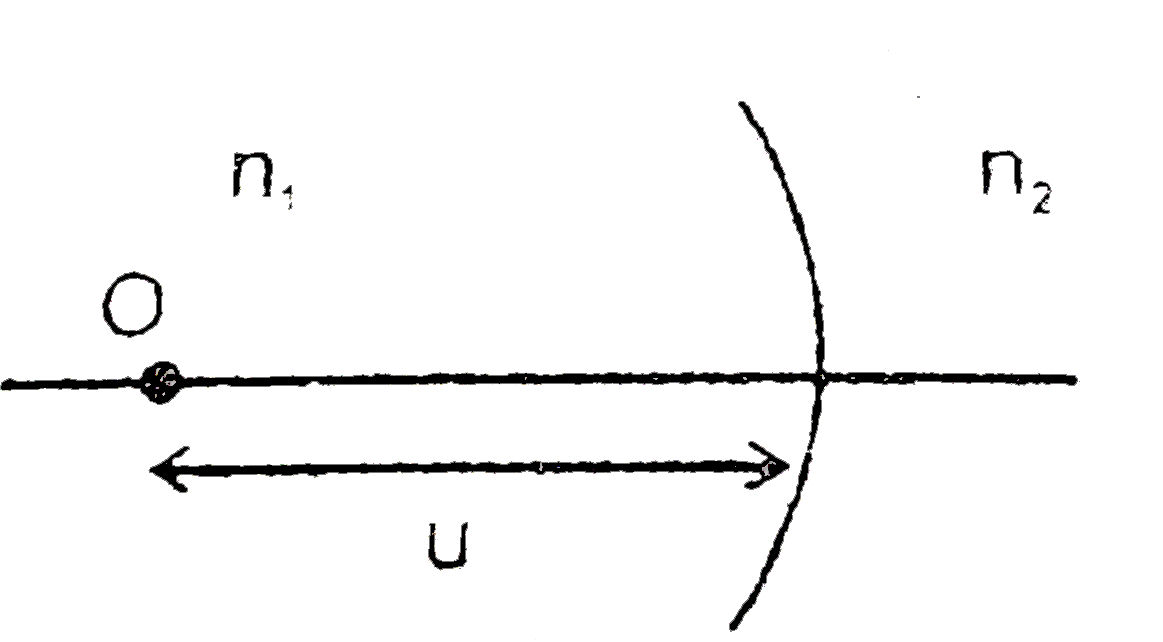All objects referred to the subsequent problems lie on the principal axis.

In above question if the object is real, then the final image formed after two refractions :
may be real
may be virtual
must be virtual
both and
The correct Answer is:D

Consider object on left side of spherical surface seperating two media.
If real object is in rarer media i.e.
Then
Hence image shall be virtual for a real object lying
on concave side with rarer media....(1)
If real object is in denser media i.e.
Image is real if
or .....(2)
and image is virtual if ...(3)
From statements and we can easily conclude the answers.
Topper's Solved these Questions
- DAILY PRACTICE PROBLEMBook:RESONANCE ENGLISHChapter:DAILY PRACTICE PROBLEMExercise:DPP No.11
Explore 20 Videos
- DAILY PRACTICE PROBLEMBook:RESONANCE ENGLISHChapter:DAILY PRACTICE PROBLEMExercise:DPP No.12
Explore 9 Videos
- DAILY PRACTICE PROBLEMBook:RESONANCE ENGLISHChapter:DAILY PRACTICE PROBLEMExercise:DPP No.9
Explore 20 Videos
- CURRENT ELECTRICITYBook:RESONANCE ENGLISHChapter:CURRENT ELECTRICITYExercise:High Level Problems (HIP)
Explore 19 Videos
- ELECTRO MAGNETIC WAVESBook:RESONANCE ENGLISHChapter:ELECTRO MAGNETIC WAVESExercise:Exercise 3
Explore 27 Videos
Similar Questions
All objects referred to the subsequent problems lie on the principal axis.

If light is incident on surface 1 from left, the image formed after the first refraction is definitely :
View SolutionAll objects referred to the subsequent problems lie on the principal axis.

If light is incident on surface 2 from right then which of the following is true for images formed after a single refraction.
View SolutionIn the figure shown , a point object O is placed in air on the principal axis. The radius of curvature of the spherical surfaces is 60cm. I is the final image formed after all reflections and refractions.

View SolutionFigure shows a point object and a diverging lens

Find the final image formed.
View SolutionFigure shows a point object and a converging lens. Find the final image formed.

View SolutionAn object is placed on the principal axis of a concave mirror at a distance of 1.5 f(f is the focal length). The image will be at,
View SolutionA convex lens of focal length f and a plane mirror are y distance apart. An object O is kept on the principal axis of the lens at a distance x from the lens. The values of x and y for the final image of O to fall exactly (position and size) on the object O are :

View SolutionIn Figure, a point object O is placed in air. A spherical boundary separates two media. Ab is the principall axis. The refractive index above AB is 1.6 and below AB is 2.0. The separation between the images formed due to refraction at a the spherical surface is (assume the radius of curvature (R) to be 1 unit)

View SolutionMirror in the arrangement shown in figure is moving up with speed 8cm/sec. There is an object O outside water. Speed of final image formed after two refraction and one refraction and the reflection is :
 .
.
View Solution
The distance between a convex lens and a plane mirror is 10 cm. The parallel rays incident on the convex lens after reflection from the mirror forms image at the optical centre of the lens. Focal length of lens will be
View Solution